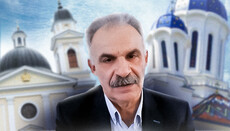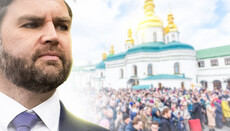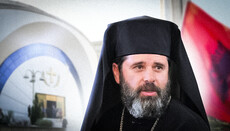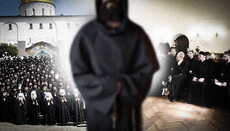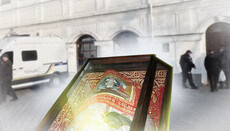Christmas remapping as a step to the new union
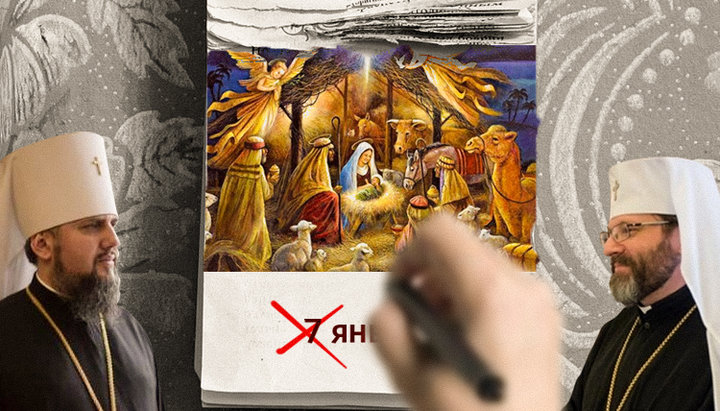
What are the true motives of current attempts to shift the date of celebration of the Nativity of Christ from the "old" to the "new" style?
Last year, talks about the need for a change in the church calendar picked up momentum in Ukraine. Most often, such statements are made by representatives of the Orthodox Church of Ukraine, and more recently – of the Ukrainian Greek Catholic Church.
In many schismatic "dioceses", local "hierarchs" and "clergy" have already decided to move from words to deeds.
For example, on December 25, the infamous “metropolitan” of Lutsk and Volyn, Mikhail Zinkevich, performed a “Christmas service” for those who wished so.
On the same day, a similar service was held for the first time in the Mukachevo-Carpathian, Kherson and Zhytomyr-Polessye "dioceses" of the OCU.

The arguments in favor of such celebrations, voiced by their initiators, go far beyond purely ecclesiastic issues. For example, Zinkevich said that the celebration of Christmas in the old style, i.e. January 7, is simply the “power of habit” and “Moscow yoke”, which is high time to lift up. He is sure that it was precisely the cause of "Maidan".
The head of the Mukachevo-Carpathian "diocese", Viktor Bed', called the "alternate" celebration as a "transitional stage" on the way to the unified celebration by the "new style" on December 25.
Other “bishops” and “priests” of the OCU, who held their Christmas “services” on December 25, also showed up for the media. According to the OCU "metropolitan" Ioan of Cherkassy, the celebration of Christmas in December "will be a step towards and effective gratitude to the Patriarchate of Constantinople and will help to disidentify the OCU with the Moscow Church."
What is behind this step, besides this disidentification? In other words, who do the Ukrainian schismatics want to identify themselves with?
Ground Softening
The “calendar issue” is accompanied by mass hysteria, fueled by the Ukrainian media. Long before the scheduled date, several “believers” of Volhynia wrote a letter to “metropolitan” Mikhail, in which they asked him about the Christmas “worship” to be held on December 25. Zinkevich supported the idea alongside other "hierarchs" of the OCU – Victor Bed', Adrian Kulik, Ioan Yaremenko and the head of the organization, Epiphany Dumenko.
Political forces joined the rant about changing the calendar. The so-called “Galician Party”, which is directly associated with the Ukrainian Greek Catholic Church, believes that the issue of “European” Christmas is almost the main item on the agenda of modern Ukraine. Members of this party even staged a rally near the walls of the Holy Assumption Pochaev Lavra to collect signatures for the "new date".
Mass polls, an active advertising campaign, and media interest should create a picture that the time has come for changing the calendar. After all, as Dumenko stated, the OCU will agree to the transition from the old to the new style as long as Ukrainians want it.
However, Ukrainians do not want it so far.
Attempts by the media to cause a public outcry are caused by the desire of certain forces not only to probe the soil but also to prepare the people for the inevitability of "calendar reform".
Mass polls, an active advertising campaign, and media interest should create a picture that the time has come for changing the calendar.
So far, despite the titanic efforts of the OCU and the authorities (especially the former), much has not been achieved. According to a recent study by the Rating Sociological Group, only 25% of Ukrainians support the idea of shifting Christmas celebrations from January 7 to December 25. 64% of respondents are against such an idea. Another 7% said that they did not care about the matter, while 4% found it difficult to answer. According to the Group, in three years the number of supporters of the transition has increased by 10% (from 15 to 25), while the number of opponents has decreased only by 5% (from 69 to 64).
Dumenko believes that the time for radical action on the calendar has not yet arrived. For the time being – because "most of the Orthodox, and not only Orthodox but also Ukrainians in general, unfortunately, do not accept this reform."
On the air of UA: Rivne, he said that the OCU will consider synodically the issue of transition to the new style, when opinion polls show the corresponding figures: “Now we can see that 64% are against, 25% are for. If at least there is the same figure – the majority, 64%, let them support more than 50%, then we will consider this issue.”
Therefore, the transition for the OCU to the new style is only a matter of time.
Will this time arrive?
At the same time, there is a semblance of opposition to the calendar change inside the OCU. But even those who are “against” are actually “for”. It's just not the right time.
The most active supporter of the point of view that such a date shift is not relevant is Eustraty Zoria. On his Facebook page, he wrote that “hasty calendar reform (and even ill-conceived attempts to hype it with proposals of ‘double celebration’ now) potentially ‘conserve’ thousands of communities with millions of believers in the Moscow Patriarchate and bring confusion to Ukrainian Orthodoxy for decades to come.”
The practice of double celebration is “criticized” on the ground. The “priest” of the OCU from Volyn (a defector from the UOC), Viktor Martynenko, believes that all the latest “calendar” rhetoric of Mikhail Zinkevich is plain populism and a desire to cut a dash in the media. “The candle- ammunition theme is over, so the ‘cutting-edge’ Christmas has begun?” he asks the “hierarch”.
There is a semblance of opposition to the calendar change inside the OCU. But even those who are “against” are actually “for”. It's not just the right time.
Martynenko is sure that the solution to the calendar problem should be comprehensive and include not only Christmas but also other holidays: “I wonder if the Volyn hierarch, who is celebrating Christmas today, will be consistent and will thus celebrate Epiphany Day on January 6, the Meeting of the Lord on February 2, the Annunciation – on March 25, and the Transfiguration of the Savior – on August 6."
Martynenko himself, subtly feeling the mood among the leadership of the OCU, supports the idea of changing the calendar but as long as the introduction of a new church calendar is "preceded by awareness-raising among the believing people, which may take decades."
He is echoed by another “priest” of the OCU, Alexander Dediukhin, who wrote on his Facebook page that “the work on the transition to the New Julian calendar is underway. The process will not be simple, but each of us can contribute to it, help enlighten souls sitting in the darkness and shadow of the Muscovite Middle Ages, and work with members of your church communities. I think there should be a certain transitional period, five to ten years, and then everything will work out.”
Simultaneous celebration for OCU and UGCC
Alongside the OCU, the UGCC started talking about the need to switch to a new calendar. Many Uniates (as well as many representatives of the OCU), who believe that the calendar reform is necessary, do not provide any church arguments in its favor. The main thing for them is to escape from the “Moscow style”.
At the same time, they consider clear synchronization with the OCU extremely important. According to Taras Antoshevsky, editor-in-chief of the Uniate website RISU, “without synchronization, it makes no sense to do this. Now for the OCU, the question of the date of Christmas celebration would be a step towards determining whether we are independent. The mother church for the OCU is Constantinople, which celebrates Christmas on December 25, but we remain in the ‘Moscow style’. And for the UGCC it’s just a matter of consistency, because in the Diaspora people live according to the Gregorian calendar, and it would be normal if that was the case in the whole Greek Catholic world. It would be better if this happened simultaneously – both in the OCU, in the UGCC, and in other Churches of Ukraine.”
Finally, the Head of the UGCC, Sviatoslav Shevchuk, in his turn declared the need for the reform: “We must look for ways to switch to the Gregorian calendar.”
But let us pay attention to the main emphasis in his statement: the UGCC will only switch to the “new style” together with other Churches: “When we do this, we must realize that we must move together so that changing the calendar does not destroy the internal unity of any of the Churches.” Shevchuk, of course, means the OCU, since this issue is not relevant for any other faiths of Ukraine.
Gregorian or New Julian?
Epiphany Dumenko, who is a “Doctor of Theology,” does not know that part of the Local Churches do not live according to the Gregorian calendar but according to the New Julian calendar: “Most local Orthodox Churches celebrate Christmas according to the new Gregorian calendar.”
In fact, the Patriarchate of Constantinople, in order not to approve the Gregorian calendar as “emanating from the Catholic pope,” in 1923 decided to introduce a calendar developed by the Serbian astronomer, professor of mathematics and celestial mechanics of the University of Belgrade Milutin Milankovic.
In this calendar, called New Julian, unlike in the Gregorian, not 3 days in 400 years but 7 days in 900 years are omitted. Thus, at the moment it coincides with the Gregorian calendar but only until the year of 2800 when the difference between them becomes very significant.
Epiphany Dumenko, who is a “Doctor of Theology”, does not know that part of the Local Churches does not live according to the Gregorian calendar but according to the New Julian calendar.
In 1924, the New Julian calendar was adopted by the Constantinople and Romanian Churches, in 1928 – by Alexandria and Antioch, and later by some others. The Russian, Serbian and Jerusalem Churches and the Holy Mount Athos use the old Julian calendar. Not only by virtue of tradition but also because, as Metropolitan Luke (Kovalenko) of Zaporizhzhya said, “the new-style Easter is categorically unacceptable for the Church, which directly violates Her canons (the 7th apostolic rule of the definitions of the Council of Nicaea and the 1st rule of Antioch Local Council), which is associated with both movable holidays and St. Peter fast, which may be absent in the Gregorian calendar.”
However, for those who want to radically reform the Church, draw Her closer to Europe and, ultimately, to non-Orthodox Christians, the issue of changing the calendar is one of the priorities.
Calendar reform and the issue of unification of Churches
It is no coincidence that the Chancellor of the canonical Ukrainian Orthodox Church, Metropolitan Anthony (Pakanich), believes that Patriarch Bartholomew most likely insists on the calendar reform. But why?
At the beginning of the 20th century, Phanar approached the reform of the calendar as a tool to be able to unite Orthodox Churches with heterodox Christian denominations – Catholics and Protestants.
In 1920, the Patriarchate of Constantinople, then headed by the locum tenens, Metropolitan Dorotheos of Brussia, issued a special encyclical entitled “To the Christian Churches Found Across the World”. The document expressed particular hope for a productive ecumenical dialogue aimed at resolving contradictions in the relations of scattered Christian denominations in order to “prepare and facilitate the full work, with the help of God, of the blessed reunion of all Churches”.
Phanar called Protestants and Catholics "joint successors and fellows in Christ", and one of the most important means of achieving inter-Christian unification is "the adoption of a common calendar for the celebration of the great Christian holidays for all Churches".
The calendar reform was implemented to one degree or another by Patriarch Meletius (Metaxakis), a famous freemason and reformer, who in 1923 convened the so-called "Pan-Orthodox Conference" (May 10 - June 8, 1923). In addition to the organizers, not a single Eastern Church participated in the event. However, this did not prevent the patriarch from approving the so-called “new style” at the “Pan-Orthodox Conference”, which was subsequently imposed on some Local Orthodox Churches in the orbit of Phanar’s influence.
Phanar called Protestants and Catholics "joint successors and fellows in Christ", and one of the most important means of achieving inter-Christian unification is "the adoption of a common calendar for celebration of the great Christian holidays for all Churches."
But in these Churches, calendar reform faced such an adamant opposition from the clergy and laity that it was hard to imagine. Metropolitan Luke of Zaporizhzhya rightly notes: “Many monks of the Valaam Monastery in the twenties and thirties became martyrs and confessors. Finding themselves in the occupation of the Finnish Orthodox Church, which, being conquered by Constantinople, began to introduce new-style worship, affecting, among other things, the Easter service circle, true zealots of the faith refused to accept this novelty and were expelled or tortured ... Many Churches, which adopted the new style, split over this concession to the world. In Greece, Romania, Bulgaria, America there were parishes that refused to switch to the Gregorian calendar. A logical question then arises: was this reform worth it to seduce tens of thousands of people in this way?”
The position of the Patriarchate of Constantinople raised a lot of questions from those who adhered to the "old style". One of them, who fell into the “old-style” Greek schism, Metropolitan Chrysostomos wrote: “Indeed, the acts of the Conference, like the 1920 encyclical, constitute a kind of violence against the consciousness of the Unified Orthodox Church. These decisions further removed the throne of Constantinople from unity with other Local Churches. Thus, the decree on the new style was contrary to the unanimous decision of the Autocephalous Churches, expressed during the exchange of opinions in 1902-1904. By the calendar issue being of not at all secondary importance, the decision on which could be made only subject to pan-Orthodox unanimity, the Church of Constantinople actually split the universal unity of the autocephalous Churches.”
But, apparently, the issue of unity with the Catholics, as well as the creation and promotion of the OCU, is more important for Phanar than the issue of the unity of the Orthodox Church.
* * *
In the aftermath of the so-called “Unification Council” of the OCU, Epiphany Dumenko said that he had developed a roadmap for developing cooperation with the UGCC.
The Head of Ukrainian Uniates, Sviatoslav Shevchuk, replied that he clearly sees a joyful prospect of Eucharistic communion with the OCU.
Its elements from time to time break into public space, as it was at the "consecration" of the temple in the city of Varash when, together with members of the OCU, Catholic priest Vasily Plakhotka took part in the "liturgy".
And most importantly, this prospect is also supported at Phanar. The Archbishop of the Patriarchate of Constantinople, Daniil of Pamphylon, emphasized in an interview with the BBC, “I am sure that this (the unification of the OCU and the UGCC – Ed.) is quite possible. Their spiritual fathers, the predecessors, namely Bishop Andrey Sheptitsky, Joseph Slepoi and other hierarchs, have repeatedly said that when the Orthodox Church of Ukraine has its self-identity, Greek Catholics will have to find a way to unity with this Church.”
Apparently, Ukraine was indeed chosen as a testing ground for working out the union of the Orthodox with Catholics. According to Shevchuk, “today Ukraine has even more reasons to be called a laboratory of ecumenism, and the UGCC does not want to be an obstacle, but its catalyst."
Thus, by creating the OCU, Patriarch Bartholomew sought, in addition to gaining control over thousands of parishes in Ukraine, other goals. Namely, to form a structure that can become an experimental site for a "fraternal" connection with Rome. But such a goal must be achieved step by step. The calendar reform seems to be one of them and most likely, the UGCC and the OCU will take such a step simultaneously.
